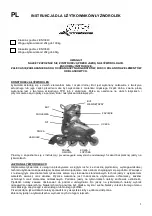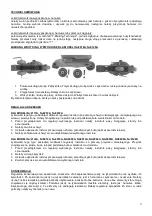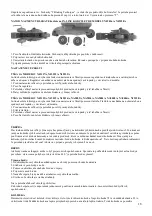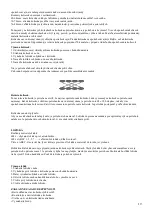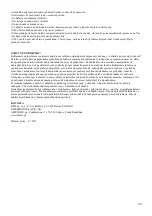
7
The bolt should not be tightened too heavily.
For safety reasons it is suggested to use self-locking nuts only once, as their performance level may deteriorate
with time.
WHEELS
The durometer indicates wheels hardness – the higher the number, the harder the wheels. I.e. wheels 78A – are
soft wheels, 92A are hard wheels. Soft wheels adapt better to the road and provide better traction. Hard wheels
wear slower and provide lower traction and lower skating comfort.
The wheels dimensions are in milimetres.
60-64mm – small wheels with low centre of gravity, help the beginners to keep stability.
70-72mm – medium wheels, used for long distances and recreational skating.
76-82mm – big wheels, used for fast skating, the most durable for medium experienced and experienced skaters.
The wheels wear during skating and shall be replaced from time to time. The wear rate depends on many factors,
such as: skating style, surface, height and weight of the skater, weather, the wheels material and their hardness.
Wheels wear faster on the inner side. The front wheels wear faster than the middle and back ones. The wheels
rotation is suggested after skating for about 70 km or in case of visible signs of wear.
Wheels replacement:
1. Unscrew the wheels axis bolts using appropriate tool.
2. Remove the wheel from the chassis.
3. Remove the bearing from the wheel.
4. Put the bearing with sleeve into the wheel.
5. Install the wheels on the chassis and tighten the axis bolts.
The wheels fixing bolts should not be tightened too strongly.
For the safety reasons it is suggested to use the self-locking nuts only once.
Wheels rotation.
During rotation of wheels make sure that the most worn wheel will interchange its position with the less worn one.
Each wheel with bigger wear on the inner side shall be positioned in a way that the more worn side faces the
outside. It will provide uniform wear of wheels. The operation should be realised according to the below scheme:
The wheels do not move freely.
To make the new wheels rotate freely, they must be grinded-in. The bearings are tightly fixed and require load for
optimum efficiency. Make also sure, that the bolts are not tightened too strongly.
BEARINGS
The most common types of bearings are:
608 z – common bearings for beginners.
ABEC 1, 3, 5, 7… - good bearings with high durability.
The bigger the number by ABEC, the better the bearing’s precision and the material of which it was made.
Good quality of bearings ensures fluent skating. All bearings were greased and do not require next lubrication.
Dusty, greasy and wet surfaces should be avoided. Wet or damp bearings should be dried with clean cloth. Worn
out bearings must be replaced.
Bearings replacement
1. Remove the wheels from the chassis.
2. Remove the bearing from the wheel using appropriate tool
3. Remove the sleeve and the second bearing.
4. Clean the bearing with dry cloth or replace it with new one.
5. Insert the bearing into the wheel.
6. Inert the sleeve and the second bearing.

